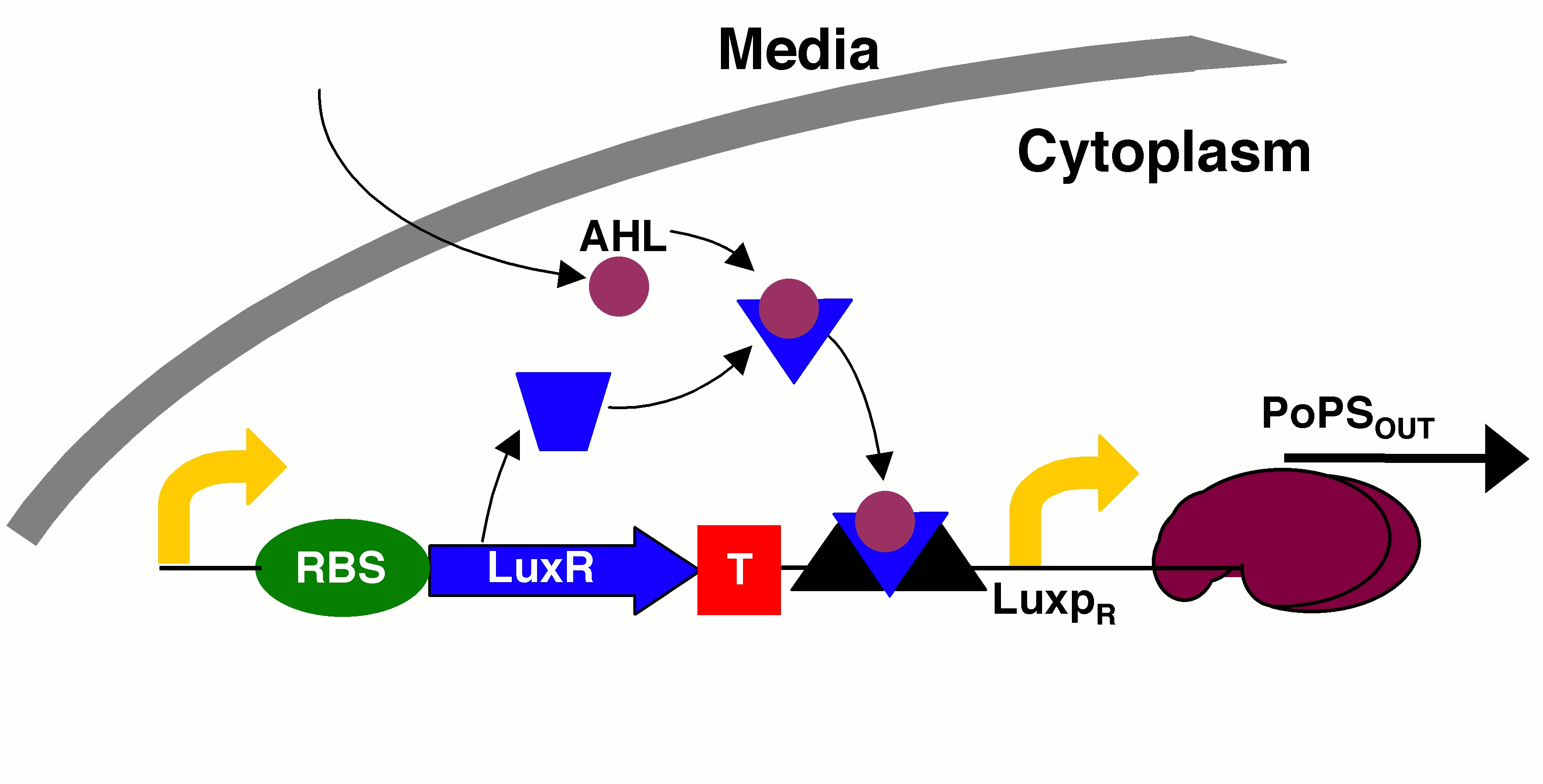Difference between revisions of "Featured Parts:Cell-Cell-Signaling"
Smelissali (Talk | contribs) (→Introduction) |
(fixed image) |
||
| Line 17: | Line 17: | ||
<br style="clear:both" /> | <br style="clear:both" /> | ||
====LuxR Receiver Family==== | ====LuxR Receiver Family==== | ||
| − | [[Image:Luxrreceiverschematic. | + | [[Image:Luxrreceiverschematic.png|thumb|right|500px|LuxR receiver device mechanism]] |
A schematic of device operation is shown right. The AHL molecule is recognized by a member of the LuxR protein family. This AHL-LuxR complex can bind to an operator site upstream of a [http://rosalind.csail.mit.edu/r/parts/partsdb/view.cgi?part_id=192 Luxp<sub>R</sub>] family promoter and activate transcription. The exact mechanism and stoichiometry of this activation have not been fully resolved. The degree of transcriptional activation can be set by varying the specific receiver protein, signaling molecule or promoters used. | A schematic of device operation is shown right. The AHL molecule is recognized by a member of the LuxR protein family. This AHL-LuxR complex can bind to an operator site upstream of a [http://rosalind.csail.mit.edu/r/parts/partsdb/view.cgi?part_id=192 Luxp<sub>R</sub>] family promoter and activate transcription. The exact mechanism and stoichiometry of this activation have not been fully resolved. The degree of transcriptional activation can be set by varying the specific receiver protein, signaling molecule or promoters used. | ||
| − | '''Device Input:''' Acyl homoserine lactone (AHL)<br> | + | '''Device Input:''' Acyl homoserine lactone (AHL)<br/> |
| − | '''Device Output:'''[[Help:Glossary:P#PoPS (Polymerase Per Second)|PoPS]]<br> | + | '''Device Output:'''[[Help:Glossary:P#PoPS (Polymerase Per Second)|PoPS]]<br/> |
| − | '''Relevant Device Characteristics'''<br> | + | '''Relevant Device Characteristics'''<br/> |
*[[Featured Parts:Cell-Cell-Signaling/Transfer function|Transfer function]] | *[[Featured Parts:Cell-Cell-Signaling/Transfer function|Transfer function]] | ||
*Variation in transfer function | *Variation in transfer function | ||
Revision as of 02:42, 13 June 2006
Contents
Introduction
Coordinating the behavior of cells within a population requires cell-cell signalling. Information transfer between different groups of cells can also be enabled by cell-cell signalling. The registry contains parts and devices to enable this inter-cell communication.
Cell-cell signaling technology
Most of the existing methods to enable cell-cell signaling borrow technology from bacterial quorum sensing systems Bassler. The best characterized of these is the LuxI/R system from V. fischeri Nealson. LuxI is a synthase that converts SAM into a small molecule called an acyl-homoserine lactone (AHL). That molecule can diffuse across cell membranes and is stable in growth media at a range of pH. LuxR is a constitutively expressed protein that can bind AHL. When bound to AHL it can stimulate transcription from the right hand lux promoter. In the natural system, this promoter controls transcription of the LuxI enzyme leading to a positive feedback loop that increases transcription from the right hand lux promoter. In addition controlling the transcription of luxI, the promoter also controls transcription of luciferase.
A range of similar systems exist in other bacteria using homologous proteins that synthesize and respond to slightly modified versions of the V. fischeri AHL molecules. Differing levels of cross-talk exist among these different systems.
Device classes
A minimal set of devices to enable cell-cell signaling is a sender device and a receiver device. These devices are sufficient to enable basic communication between cells in a population of bacteria. These devices have been defined and some proofs of concept tested. We expect that further classes of devices will be described in the future.
Sender devices 
Currently, we define a sender device as a device that accepts an input of PoPS and outputs a rate of signaling molecule synthesis.
Receiver devices 
We define a receiver device as a set of genetic elements that responds to an extracellular input signal by changing the PoPS output from the device. That input signal might be any biomolecule produced by other cells in the same environment. While we can envisage a number of families of receiver devices we are currently developing a family based on the Lux System of V. Fischeri. This device family is described below.
LuxR Receiver Family
A schematic of device operation is shown right. The AHL molecule is recognized by a member of the LuxR protein family. This AHL-LuxR complex can bind to an operator site upstream of a [http://rosalind.csail.mit.edu/r/parts/partsdb/view.cgi?part_id=192 LuxpR] family promoter and activate transcription. The exact mechanism and stoichiometry of this activation have not been fully resolved. The degree of transcriptional activation can be set by varying the specific receiver protein, signaling molecule or promoters used.
Device Input: Acyl homoserine lactone (AHL)
Device Output:PoPS
Relevant Device Characteristics
- Transfer function
- Variation in transfer function
- Latency
- Specificity
- Stability
- Demand
The parts
Senders
Receivers
Other relevant parts & devices
- BBa_I13015(currently listed as missing in the registry database, this is a sender device controlled by an inducible pBAD promoter.)
- All the senders and receivers listed above use the 3OC6HSL signaling channel, however there are senders and receivers and the component parts specified or existing for each of the other well known signaling channels.
References
<biblio>
Bassler pmid=16212498
Nealson pmid=396467
</biblio>

